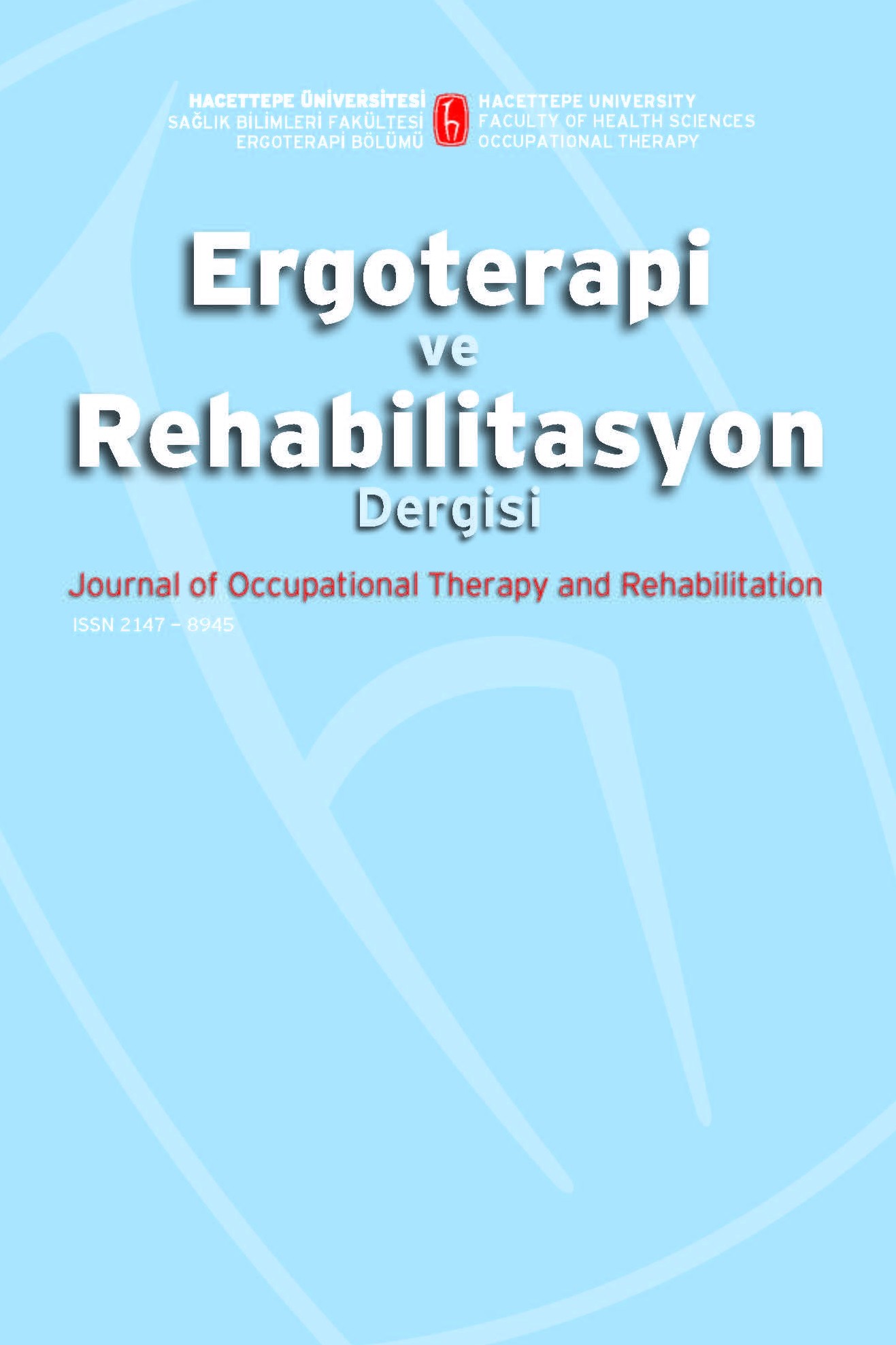Erişkin Nöromusküler Hastalıklarda Üst Ekstremite Fonksiyonlarını Değerlendiren Yöntemlerin Karşılaştırılması
Amaç: Nöromusküler hastalıklarda (NMH), üst ekstremite fonksiyonel kapasitesini değerlendirmek amacıyla kullanılan 4 yöntemi karşılaştırmak, avantaj ve dezavantajlarını saptayarak en uygun değerlendirme yöntemlerini ortaya çıkarmaktır. Gereç ve yöntem: Çalışmaya sadece kas tutulumu bulunan musküler distrofiler grubu, inflamatuar miyopatiler grubu ve diğer miyopatiler grubundan, toplam 60 hasta alınmıştır. Olgulara başlangıçta ve 15 gün sonra dinamometrik kas testi, kavrama kuvveti, fonksiyonel değerlendirme (FD), Minnesota el beceri testi (Minnesota EBT), Fonksiyonel bağımsızlık ölçeği (FBÖ), Kol, omuz ve el sorunları anketi (DASH) değerlendirmeleri uygulanmıştır. Sonuçlar: Çalışmaya katılan olguların yaş ortalamaları 32.25±12.36 yıl idi. Çalışmamızın sonuçları FD, Minnesota EBT, FBÖ ve DASH’ın NMH’larda hastaların fonksiyonel kapasitelerini değerlendirmek amacıyla kullanılabilecek geçerli ve güvenilir yöntemler olduğu bulunmuştur (p<0.05). Tartışma: Çalışmamızın sonuçları, nöromusküler hastaların tam ve kapsamlı bir şekilde değerlendirilmesini sağlayarak, hastalığın seyrinin belirlenmesinde, uygun tedavi programının seçilmesinde, tedavi yönteminin etkinliğinin belirlenmesinde ve olası komplikasyon risklerinin önceden bilinmesine olanak sağlayacak değerlendirme yöntemlerini klinisyenlerin kullanımına sunmuştur
Anahtar Kelimeler:
Nöromusküler hastalıklar, Üst ekstremite fonksiyonel değerlendirmesi, Minnesota el beceri testi, Fonksiyonel bağımsızlık ölçeği, Kol, Omuz ve El sorunları anketi
The Comparison of Upper Extremity Functions Evaluation Methods in Adult Neuromuscular Disorders
Purpose: The study that was aimed to compare 4 different upper extremity functional capacity evaluation methods in neuromuscular patients. Material and Methods: Sixty subjects with muscle weakness due to muscular dystrophy, inflammatory myopathy and other myopathies were included in the study. The patients were evaluated with dynamometric muscle strength, grip strength, functional assessment (FA), Minnesota hand dexterity (MHDT) test, functional independence measurement (FIM), disability of arm shoulder and hand questionnaire (DASH), at the beginning of the study and 15 days afterwards. Results: The mean age of the patients included to the study was 32.25±12.36 year. According to the evaluations results it was thought that FE, MHDT, FIM and DASH could be used as a valid and reliable method in neuromuscular diseases (p<0.05). conclusion: In conclusion the results of our study showed that complete and detailed evaluation in neuromuscular patients provide to determine the progress of the illness to select the proper treatment program to show effectiveness of the treatment method to predict the possible complication risk
Keywords:
Neuromuscular diseases, Upper extremity functional assessment, Minnesota hand dexterity test, Functional independence measurement, Disability of arm shoulder and hand questionnaire,
- ISSN: 2147-8945
- Yayın Aralığı: Yılda 3 Sayı
- Başlangıç: 2013
- Yayıncı: Hacettepe Üniversitesi Sağlık Bilimleri Fakültesi
Sayıdaki Diğer Makaleler
Muhammed KILINÇ, Sibel Aksu YILDIRIM, Hülya KAYIHAN
Meral HURİ, Esra AKI, Gonca BUMİN, Fatih KAREL
Amatör Sporcu Çocuklarda Benign Eklem Hipermobilitesi, Ağrı ve Yaşam Kalitesinin İncelenmesi
Fizyoterapistlerin Çalişma Kapasitesinin Belirlenmesi
Winchester Sendromlu Bir Olguda Fizyoterapi ve Ergoterapinin Etkileri
Songül ATASAVUN UYSAL, İpek ALEMDAROĞLU, Öznur YILMAZ, Hülya KAYIHAN, Ayşe KARADUMAN
